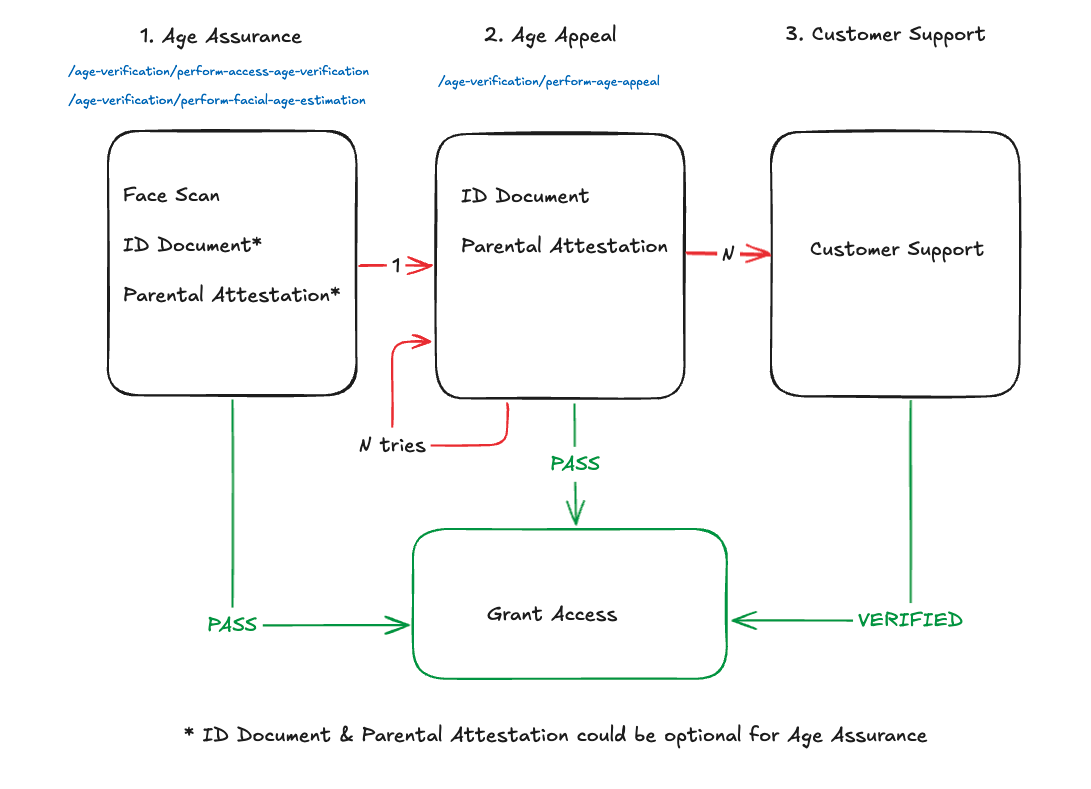实施年龄保证
年龄保证被定义为证明用户年龄以用于各种目的的整体过程,包括访问游戏、应用程序或应用程序内的内容。根据司法管辖区和您希望验证年龄的功能的风险程度,可以应用不同的方法。全球合规引擎提供了一个由API驱动的整体工作流程过程,可按司法管辖区配置,并可根据游戏或应用程序的独特需求进行自定义。
以下API可用于实施整体年龄保证过程:
/age-verification/perform-access-age-verification年龄保证,用于确定新用户是否应该访问应用程序或应用程序内的内容/age-verification/perform-age-appeal被怀疑未成年的用户在被发布者因未成年或年龄保证失败而禁止后,试图重新进入应用程序
要在您的应用程序中实施端到端的年龄保证流程,请按照以下步骤操作:
步骤I: 调用访问年龄验证API(/age-verification/perform-access-age-verification)
- 最终�用户看到所有3个验证选项(面部扫描、ID扫描和父母证明)。
- 当任何验证尝试成功完成并确定年龄时,根据用户是否满足年龄要求,通过k-ID webhook向您的应用程序发送
PASS或FAIL。 - 当验证尝试由于验证本身的问题(例如房间太暗、面部不在相机中、无效的ID卡)而无法完成时,用户将被允许重试。
- 每个验证方法都有配置的最大重试次数,即定义的最大尝试次数(目前每个方法默认为3次)。
- 如果用户对所有验证方法执行了配置的最大重试次数,则通过k-ID webhook返回
FAIL结果。
因此,webhook结果仅在3种情况下返回:
- 当验证尝试成功完成时,结果将是
PASS,或带有failureReason为age-criteria-not-met的FAIL - 当所有验证方法的最大重试次数都用尽时,结果将是带有
failureReason为max-attempts-exceeded的FAIL - 当检测到用户试图故意绕过验证方法时,结果将是带有
failureReason为fraudulent-activity-detected的FAIL
或者,您可以选择单个验证方法作为第一步使用。例如,您可以使用/age-verification/perform-facial-age-estimation仅提供面部年龄估算,并回退到其他方法。
步骤II: 如果步骤一的结果是FAIL,您可以选择允许用户通过对他们获得的结果提出上诉来重试。为此,请调用年龄上诉API(/age-verification/perform-age-appeal)
- 最终用户看到2个验证选项(ID扫描和父母证明),因为当用户已经失败或之前被应用程序禁止时,证明的负担更高。
- 当验证尝试完成时,通过k-ID webhook返回适当的结果[PASS或FAIL]。
- 当验证尝试由于验��证本身的问题(例如无效的ID卡)而无法完成时,用户将被允许重试。
- 每个验证方法都有配置的最大重试次数,即定义的最大尝试次数(目前每个方法默认为3次)。
- 如果用户对所有验证方法执行了配置的最大重试次数,则通过k-ID webhook返回FAIL结果。
步骤III: 您再次收到FAIL结果,因此您可以选择给用户另一个上诉尝试,或者您可以选择允许用户通过其他方式获得访问权限,例如通过联系客户支持。
